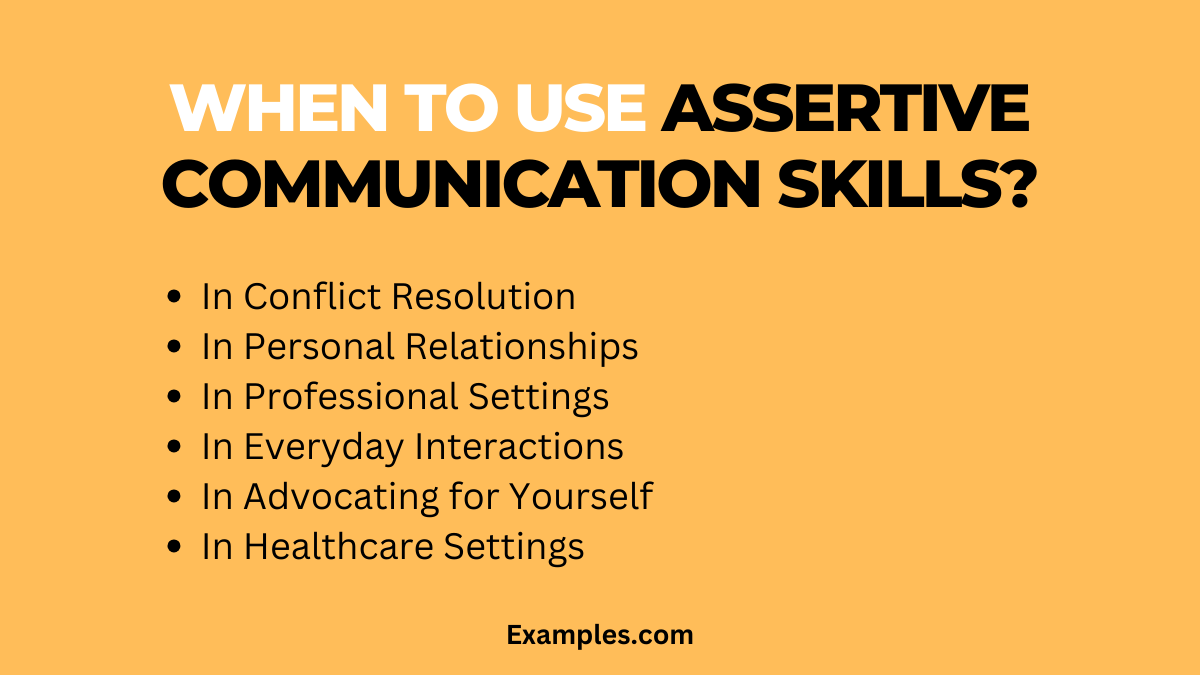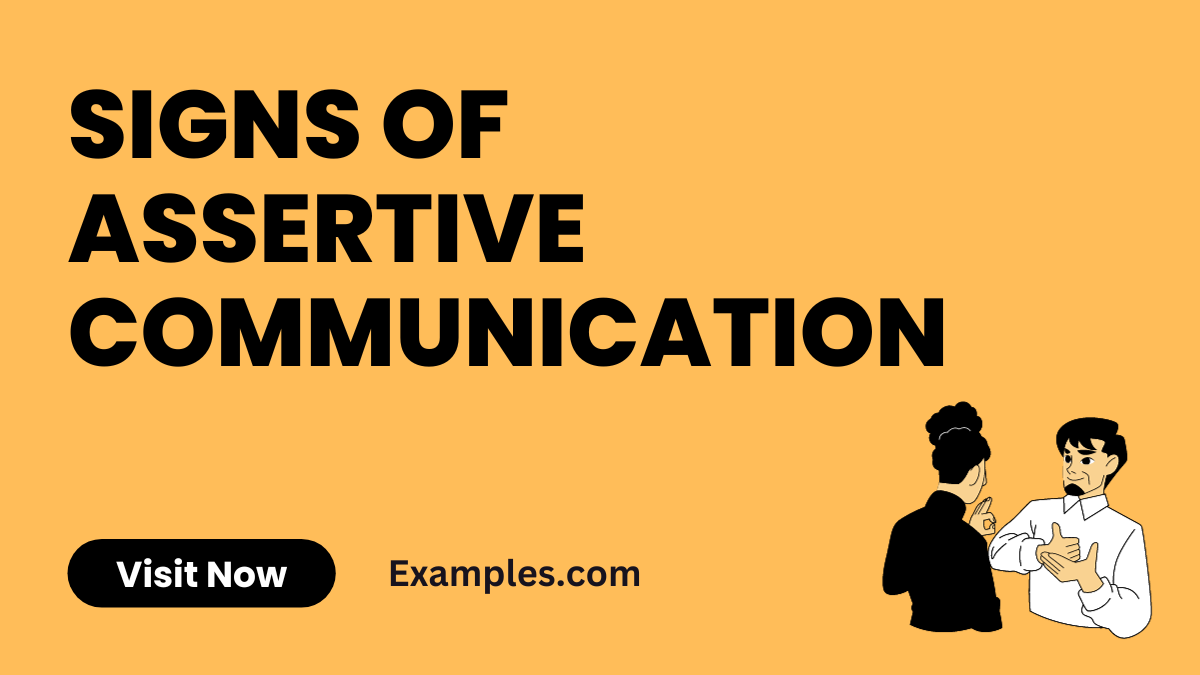Signs of Assertive Communication
Assertive communication is a key skill in fostering both personal and professional relationships. This guide is dedicated to identifying the signs of assertive communication, complete with practical communication examples. It offers insights into recognizing and understanding assertive behaviors, which balance respect for others with clearly stating one’s own needs and opinions. From maintaining eye contact to using a confident tone, this guide covers the essential traits of assertiveness. Enhance your communication skills by learning how to express yourself assertively, ensuring your message is heard and respected.
What are the Signs of Assertive Communication?

Assertive communication is characterized by several key signs that differentiate it from passive or aggressive communication styles. Firstly, assertive communicators use clear and direct language, ensuring their message is straightforward and unambiguous. They also exhibit confidence in their speech, without being overbearing. Additionally, maintaining appropriate eye contact and employing a calm, steady tone are hallmarks of assertiveness. Importantly, assertive individuals respect both their own boundaries and those of others, creating a balanced and respectful dialogue. These communication skills are essential for effectively expressing one’s thoughts and feelings while maintaining positive interpersonal relationships. Understanding these signs is crucial for effective communication.
Clear and Direct Language
- Straightforward Expression: Conveying messages in a clear, direct manner without ambiguity.
- Honesty: Speaking truthfully and openly about thoughts and feelings.
Confident Delivery
- Self-Assured Speech: Speaking with a confident tone that reflects self-assurance, not arrogance.
- Appropriate Volume: Using a voice that is audible and steady, neither too loud nor too soft.
Respectful Interaction
- Listening Actively: Giving full attention to others when they speak, showing respect for their opinions.
- Empathetic Responses: Demonstrating understanding and empathy towards others’ viewpoints and feelings.
Non-Verbal Cues
- Positive Body Language: Employing open and inviting gestures that align with spoken words.
- Maintaining Eye Contact: Engaging with others through steady, non-confrontational eye contact.
Balanced Expression
- Respecting Boundaries: Acknowledging and respecting personal boundaries of oneself and others.
- Seeking Win-Win Solutions: Striving for solutions that satisfy all parties involved in a conversation.
These signs are integral to practicing assertive communication, enabling individuals to express themselves effectively while maintaining positive and respectful relationships.
What are the Best Examples of Assertive Communication Signs?
Here is the best Examples of Assertive Communication Signs:
Confident Body Language
Confident body language, such as standing straight and open gestures, conveys self-assurance and assertiveness. This non-verbal cue demonstrates a person’s confidence in their words.
Eye Contact
Maintaining steady eye contact during a conversation is a key sign of assertiveness. It shows that you are engaged and sincere in your communication.
Statements
Using clear and direct statements, rather than vague or ambiguous language, indicates assertiveness. This sign reflects a person’s ability to express thoughts openly and honestly.
Tone of Voice
A calm and steady tone of voice is a sign of assertive communication. It implies control and respect, without being aggressive or submissive.
Active Listening
Active listening involves paying full attention to the speaker, indicating respect and a willingness to understand their perspective.
Clarity
Expressing oneself with clarity, without being overly elaborate or confusing, is a sign of assertive communication. It shows the ability to convey messages effectively.
Posture
An upright and relaxed posture, without being too rigid or slouched, reflects assertive communication. It portrays confidence and openness.
Facts
Using facts to support statements is a sign of assertiveness. It shows reliance on logic and reason, rather than emotions alone.
Gestures
Appropriate and controlled gestures can enhance assertive communication. They help to emphasize points and demonstrate engagement in the conversation.
Timing
Good timing in starting and ending conversations is a sign of assertiveness. It shows respect for others’ time and an understanding of social cues.
What Does Signs of Assertive Communication Look Like?
Signs of assertive communication manifest in various ways, each signifying a balance of self-respect and respect for others. Key indicators include:
- Direct and Clear Expression: Conveying thoughts and needs straightforwardly, without ambiguity.
- Confident Tone: Speaking with assurance, yet without domineering or submissive undertones.
- Respectful Listening: Actively listening to others, showing understanding and empathy.
- Appropriate Body Language: Non-verbal cues like open gestures and steady eye contact that reinforce spoken words.
- Emotional Honesty: Expressing feelings truthfully and respectfully, without aggression or passivity.
- Boundary Setting: Clearly stating limits and respecting others’ boundaries.
These communication skills reflect a person’s ability to assert themselves effectively and respectfully in various interactions.
What are Characteristics of an Assertive Communication in Person?
Assertive communication in person is distinguished by several distinctive characteristics:
Direct and Honest Expression
- Clarity: Communicating thoughts and needs clearly without ambiguity.
- Honesty: Expressing true feelings and opinions openly.
Balanced Tone and Volume
- Moderation: Using a tone that is neither too aggressive nor too submissive.
- Volume Control: Speaking neither too loudly nor too softly, but assertively.
Respectful Listening
- Active Listening: Paying full attention to others while they speak.
- Empathetic Response: Showing understanding and empathy in replies.
Body Language
- Positive Gestures: Using body language that conveys confidence, like steady eye contact and open posture.
- Non-Verbal Cues: Avoiding aggressive or passive non-verbal signals.
Emotional Intelligence
- Self-Control: Managing emotions effectively during interactions.
- Sensitivity: Being aware of and respectful towards the emotions of others.
These characteristics are vital for effective face-to-face interactions, ensuring that communication is not only assertive but also conducive to positive and productive relationships.
When to Use Assertive Communication Skills?

Assertive communication is a powerful tool that can be used in a variety of situations to effectively convey your needs, thoughts, and feelings while respecting others. Here are some scenarios where assertive communication is particularly beneficial:
In Conflict Resolution
- Resolving Disputes: Assertive communication is vital when addressing misunderstandings or conflicts, as it promotes clear, respectful dialogue.
- Negotiating Compromises: It enables you to express your perspective and negotiate solutions that are acceptable to all parties involved.
In Personal Relationships
- Setting Boundaries: Assertive communication is key when you need to establish or reinforce personal boundaries.
- Expressing Feelings and Needs: It helps you to openly share your feelings and needs without aggression or passivity.
In Professional Settings
- During Meetings: Assertiveness ensures your ideas are heard and considered in a group setting.
- While Giving or Receiving Feedback: It allows for constructive feedback, fostering personal and professional growth.
In Everyday Interactions
- Making Requests or Declining Them: Assertive communication is useful for making requests in a respectful manner or saying no without feeling guilty.
- Voicing Opinions: It’s important for expressing your views in everyday conversations, ensuring you’re heard and respected.
In Advocating for Yourself
- During Performance Reviews: Assertiveness can help you advocate for your achievements and discuss promotions or raises.
- When Facing Unfair Treatment: If you’re treated unfairly, assertive communication enables you to address the issue directly and respectfully.
In Healthcare Settings
- Discussing Health Concerns: Assertive communication is crucial in healthcare settings, allowing patients to clearly express their health concerns and preferences.
Using assertive communication in these scenarios enhances clarity, mutual respect, and understanding, making interactions more effective and satisfying.
How To Be An Assertive Communicator In Simple Steps?
Being an assertive communicator involves a few key steps:
Step 1: Understand Your Own Needs
- Self-awareness: Recognize your own needs, feelings, and opinions.
- Clarity: Clearly understand what you want to communicate.
Step 2: Use Clear and Direct Language
- Conciseness: Be brief and to the point.
- Directness: Speak openly and honestly without being aggressive.
Step 3: Practice Active Listening
- Empathetic Listening: Show genuine interest in understanding others’ perspectives.
- Feedback Reception: Encourage and consider feedback from others.
Step 4: Maintain Appropriate Body Language
- Non-Verbal Cues: Use body language that reflects confidence, like maintaining eye contact and a relaxed posture.
- Facial Expressions: Ensure your facial expressions align with your verbal message.
Step 5: Express Respect and Empathy
- Respectful Tone: Communicate in a way that respects others’ opinions and boundaries.
- Empathy: Show understanding and empathy towards others’ feelings and viewpoints.
Step 6: Stay Calm and Composed
- Emotional Control: Keep emotions in check to avoid reactive responses.
- Calmness: Stay calm, even in challenging conversations.
By following these steps, you can enhance your communication skills to express yourself assertively, ensuring your message is conveyed effectively and respectfully.
In conclusion, assertive communication is not just a skill but a necessary tool for effective interaction in various aspects of life. It bridges the gap between passive and aggressive communication, allowing individuals to express their needs and opinions respectfully and confidently. This balance is crucial for building and maintaining both personal and professional relationships. By being assertive, you respect not only your own rights and beliefs but also those of others. This mutual respect facilitates healthier, more productive interactions and contributes to a positive communicative environment.
Furthermore, assertive communication is integral to personal development and stress management. It enhances self-esteem, earns the respect of others, and allows for clear, direct, and respectful dialogue. In professional settings, assertiveness is essential for leadership, teamwork, and effective conflict resolution. It empowers individuals to express their feelings and thoughts openly, leading to more meaningful and productive collaborations.
For more insights into the importance and effectiveness of assertive communication, explore the Mayo Clinic’s article on “Reducing Stress through Assertive Communication“. Additionally, Harvard Business Publishing offers valuable perspectives on “Effective Communications in Challenging Times“, highlighting the role of assertiveness in complex and demanding environments.



